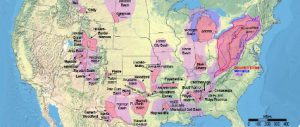Fracking now so dominates the energy debate in the United States it’s easy to forget that, until five years ago, not only was the word itself virtually unknown, but just a handful of shale-gas deposits had actually been fracked.
In Pennsylvania alone, 2,700 natural-gas wells were drilled between 2006 and March of this year. It’s not a benign abundance: fracking – full name hydraulic fracturing – entails sending as much as 19 million litres of water, sand and chemicals down a bore hole under intense pressure. At depths of up to three kilometres, the fracking fluid fractures shale formations, loosening deposits of oil or natural gas. (For a broad introduction to the fracking boom and the debate it has stirred in the United States, see chinadialogue’s March article “Gas fracking’s burning debate”.)
Each year in the United States, nearly a million oil and gas wells generate some 21 billion barrels of produced water, a mixture containing hydrocarbons and other chemicals, naturally occurring water and, in the case of fracked wells, remnant fracking fluid that comes back up to the surface with the gas. Concerns over sourcing so much fresh water, and treating such large volumes of wastewater, threaten to derail America’s fracking boom. And the industry is reacting: searching for and rolling out new technologies to make the process cleaner.
Scarcely noticed by environmentalists, lawmakers and regulators as it exploded, the fracking industry now faces scrutiny from all three. On August 4, environmental law firm Earthjustice, on behalf of more than 100 public interest groups, petitioned the Environmental Protection Agency (EPA) to draft rules compelling manufacturers to test fracking chemicals for toxicity and drillers to disclose the chemicals used to frack shale-gas deposits. The following week, congressmen Henry Waxman and Edward Markey sent a letter to EPA chief Lisa Jackson asking the agency to close a legal loophole that exempts fracking from regulation under the Safe Drinking Water Act unless diesel is used.
The EPA is developing a framework to oversee the use of diesel in fracking fluids, as well as undertaking a multi-year study on the potential impacts of fracking on drinking water and groundwater. Initial results are expected in 2012 and the final report two years later. On August 11, a US Department of Energy (DOE) advisory panel recommended mandatory disclosure of all chemicals used in the fracking process, elimination of the use of diesel in fracking fluid and improved water management and protection.
Regulators are clearly determined to make up for lost time; an industry that exploded as few were watching must now operate under the government’s gaze. Non-industry observers say the attention is long overdue. “We need to make sure that state regulators and the EPA are enforcing the laws on the books as thoroughly and vigorously as possible,” said Amy Mall, senior policy analyst at the Natural Resources Defense Council. “State regulators are overwhelmed; they don’t have the resources to keep up with this. They need to take the time to make sure that every single well that’s being drilled, every single operation, abides by every rule.”
On the front lines
It is fitting that the DOE lab that supported the critical, early research into fracking in the mid-1970s – the National Energy Technology Laboratory (NETL) – is now the centre of research into technology to mitigate its threat to the environment. NETL offices in Pittsburgh, Pennsylvania, and Morgantown, West Virginia – conveniently located above the Marcellus Shale gas play – are leading the efforts to find solutions for wastewater from fracking.
In August, NETL announced it would hand out US$10.3 million (66.3 million yuan) over three years to shale-gas projects in the states of Colorado, New York and Texas. The projects, to be overseen by NETL, with recipients kicking in US$6.7 million (43.1 million yuan) of the total cost, will test the performance of new water-treatment membranes and evaluate current well-cementing practices.
One of the first companies to receive NETL funding to treat flowback – the water left over after fracking fluid is withdrawn – and produced water is Ohio-based firm ABSMaterials. Its chief executive Stephen Spoonamore told me how his company’s technology, Osorb, works. “Osorb is glass that looks like a handful of sand, but that has been designed to swell open [at eight times its dry volume] and flow around a volatile organic molecule,” he said. “Existing treatment technologies separate dispersed oils from water; Osorb targets dissolved hydrocarbons, slicking agents and polymers that, if not removed, prevent flowback water from being recycled or discharged.”
Early results are impressive. In April, NETL reported that, in independent tests, an Osorb system removed more than 99% of oil and grease and more than 90% of dissolved BTEX (benzene, toluene, ethylbenzene and xylenes) chemicals from the wastewater. The company now has units operating in Ohio and Wyoming, and has drawn interest from major oil and gas firms, Spoonamore said. Eleven pilot projects are under way.
Not wanting to stifle innovation in a still-developing industry, NETL has directed research and development funds to companies with competing water-treatment solutions. Spoonamore explained that the solutions can be divided into two broad categories: those, like Osorb, that capture or transform the contaminant molecules, and those that recover a fraction of the freshwater by reverse osmosis, boiling or evaporation.
Technology from Altela, a company based in Denver, Colorado, falls into the second category. It was one of nine projects backed by NETL with a total of US$7 million (45 million yuan) in 2009. In April, NETL announced results from demonstration of the AltelaRain 4000 water-desalination system. After nine months of operation at a well site in Indiana County, Pennsylvania, the system treated 77% of the water stream onsite, with distilled water as the end product.
The Haynesville Shale
In fracking discussions, the Marcellus Shale rightly receives the most attention – it sits under some of the most densely populated regions in the United States and is thought to be the biggest shale-gas play in the country. But fracking has opened up other unconventional natural-gas deposits once thought uneconomical to exploit. One is the Haynesville Shale, which stretches across much of Louisiana and parts of Arkansas and Texas, in the southern United States.
Hydration Technology Innovations, (HTI) based in Scottsdale, Arizona, is active in this region. Engineer Sherwin Gormly told me the company’s specialty is forward osmosis filtration technology. The technology mimics the natural process of osmosis, wherein two solutions seek equilibrium. A salt “draw” solution and wastewater are separated by HTI’s proprietary membrane. The higher osmotic potential of the draw solution drives the filtration process, pulling water through the membrane and leaving contaminants behind.
“Fracturing can be done responsibly,” Gormly insisted, “but you need to put a certain amount of capital into developing water-treatment technologies onsite. One of the things to understand about fracturing is, whereas the rest of oil and gas exploration is an extremely well-established art, the people who invented fracturing for natural gas are doing it right now. To be quite honest, you have a lot of people who have made this up as they’ve gone along over the last 10 years.”
Incidents such as the much-publicised April blowout of a Chesapeake Energy well, in Leroy Township, Pennsylvania, have stoked concerns among the American public that fracking can contaminate drinking water. Fresh fears arose in August, when an Environmental Working Group report highlighted a 1987 EPA document that seemed to contradict the oft-repeated industry talking point that there had never been a proven case in which fracking led to contamination of drinking water. An industry group dismissed the EPA report, which linked contamination of a water well in Jackson County, West Virginia, to a nearby fracked well, as inconclusive.
“The economics of moving the volumes of water that we’re talking about tends to encourage people to cut a corner,” Gormly conceded. “If you don’t come up with solutions at the wellhead, there’s a real dangerous enticement to try to figure out ways to get water that isn’t terribly good, and get rid of water in ways that you shouldn’t.”
“Developing a suite of technologies that takes care of water and cycles it through the different needs of the life cycle of the well – where the well is – is really the key,” he said.
Amy Mall, at the NRDC, said the new water treatment technologies “definitely hold promise, but they’re still in the early stages.”
“These technologies have saved companies money. They don’t have to buy or transport as much fresh water. They don’t have as much waste to transport or treat at the end of the process. Economically, this can be a win-win solution,” she said. “But we don’t really know exactly how well they work, or what the end result is. We definitely need a lot more independent data and analysis to fully understand all of the different costs and benefits.”
Justin Gerdes is a freelance journalist based in California.
Homepage image by Meredithw shows a shale-gas drilling rig in the eastern United States.




![India, Uttarakhand, Haridwar, dam on the Ganga [image: Alamy]](https://dialogue.earth/content/uploads/2020/03/P1YATT-300x200.jpg)

